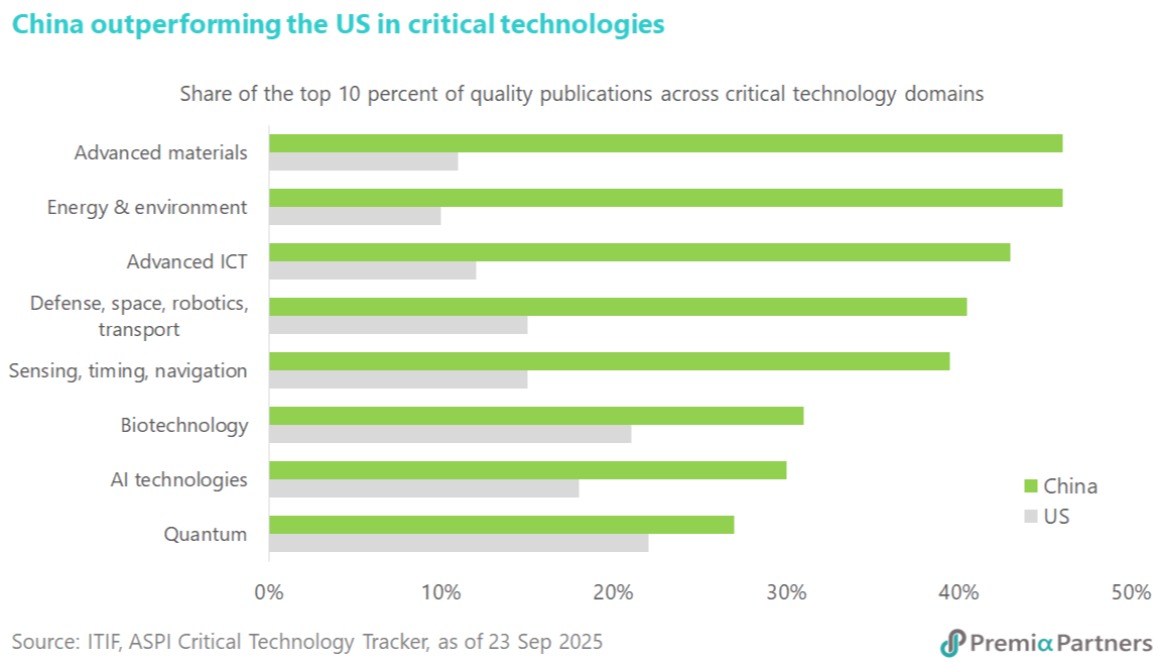
주요 인사이트 & 웨비나
On the 1 year anniversary of our China A smart beta ETFs, we thought it prudent to reflect on how 2803 HK and 3173 HK have done since launch, as well as take stock of China A-shares markets overall. In this note, we’ll recap the ETF performance and tracking, review China A-shares over the last 12 months, explore which factors worked and didn’t and offer a few thoughts about our expectations going forward. Thanks as always for reading and trusting us with your investments.
Nov 08, 2018
Innovation is increasingly a key requirement for economic growth. The story is no longer about Copied in China, but Made in China. The same is true throughout the Asian region. Unfortunately, until now, there’s been no easy and efficient way to build an Asia Innovation exposure. After months of discussions with clients, followed by months of research and data clean-up, we are pleased to announce the launch of the Premia FactSet Asia Innovative Technology Index. In this post, we cover the rationale, methodology and result of this innovative approach to capturing Asian growth. To ask us a question, or express your interest, click here.
Oct 22, 2018
While the world paints EM with a single broad-brush stroke, ASEAN markets have quietly separated from the rest of EM and may have bottomed out in July. We say quietly because no one is talking about it, with most financial media preferring to focus on the US/China trade war, Turkey’s Lira crisis, Argentina’s rate hike or some other potential problem area. There hasn’t been much news out of ASEAN of late, which may simply be because the story is not one of turmoil and difficulty but of consistent growth and opportunity.
Sep 27, 2018
China markets’ move down YTD has raised a lot of questions for Emerging Market investors, particularly given the MSCI China A inclusion earlier this year (and again in 2 weeks). But is the move down driven by a macro growth story threat, company fundamentals deterioration or a more general risk-off move amid trade war uncertainty. Our CIO, David Lai, offers his point of view on events so far and explores the potential path from here.
Aug 17, 2018
Most investors are familiar with the FAANGs and are giving increasing attention to the BATs as technology firms are disrupting traditional paradigms. Yet, one might be surprised at how significant technology-driven innovations have been reshaping the ecosystem we live in. I prefer the word “reshaping” over “disrupting” as a lot of the innovations and so-called “disruptions” have already proliferated into our blood and our everyday life – for instance, “Digital Revolution” is at the forefront of this transformation and is happening every minute around us.The exponential growth in big data, artificial intelligence (AI), and internet of things (IoT) have led to innovations in various far-reaching implications beyond merely internet and information technology. In this piece, we explore the Asia innovation theme by discussing:• State of Asia innovation• What sectors are expected to be most affected?• How are innovations disrupting traditional industry classifications and the investment landscape?State of Asia innovationAsia is home to 50 percent of the global internet users, 1.8 billion of active social media users, and about US$75 billion worth of unicorn startups. According to statistics from UNESCO on countries’ R&D spending, 3 of the top 5 are Asian countries – China #2, Japan #3, South Korea #5. These 3 countries also collectively account for roughly 40% of world researchers and are among world’s largest robotics markets as well.According to a white paper from Harvard Business Review, leading companies around the world are leveraging Asia’s liveliness and talent to develop new products, services, and business models that drive growth, with many finding or even building innovation ecosystems in Asia. Three commonly cited factors on how Asia differentiates itself from the rest of the world in the pace of innovation are: 1) the faster growing economies compared to the developed Western counterparts, 2) robust and growing demand for products and services not only from the deep and wide range of manufacturers domiciled in Asia but also from the region’s fast-growing middle class, and 3) strong support for the business community from governments that recognize the crucial role innovation plays in growing both companies and economies.What sectors are expected to be most affected?While information technology itself is a sector, with the technological innovation and development of times, technology is now more of an enabler in this modern era. Nearly every industry can find ways to benefit from innovative technologies in an effort to improve output or reduce costs. Apart from the technology sector (e.g. software, hardware), the industries that are at the forefront of experiencing tech-enabled exponential growth in Asia include:Retail: Online retailing along with online-to-offline (O2O) offerings have made shopping easier and cheaper for consumers, which were made possible by lower cost structures and improved efficiency in delivery and logistics. In How is “digital revolution” in Asia transforming the way we live, we discussed how Alibaba’s Tmall and JD.com generated impressive single day sales. In addition, AI and big data are increasingly being deployed by online and traditional retailers to better identify trends and predict customer demands.Industrials: The surge in robotics investment in Asia puts industrial automation at the forefront of Internet of Things (IoT) and implementation of AI in the physical world. With greater precision on the metal arms and an AI mind, advancement in robotics will create smarter, more capable machines to complement or replace the aging human workforce in many fields. Technology advancement will also enable better performance in other areas such as operations optimization and predictive maintenance.Healthcare: The increase in aging population and rising middle class in Asia has led to strong demand for healthcare products. In 2017, about $40 billion dollars were raised for life science projects in the region. Advanced data analytics creates large benefit to pharmaceutical companies on drug discovery and clinical trials. Physiological simulation can accelerate product development, and a 3-D printed or virtual reality-based tissue modeling can help with assessment of potential concerns. AI has also been put into use in diagnostic imaging and robotic surgery. Furthermore, innovation has made patients to be more connected and engaged that now there’s digital pills or nanobots that can go into your body (and blood) to examine and respond real-time data to you and your doctor’s digital devices. Transportation: The transportation landscape is transforming in many different ways and has affected many other sectors - I use “transportation” for the lack of a better word. In the sky, drones with intelligent sensors and accurate GPS positioning has enabled new ways of filing, package delivery, and farming. On the road, we see advancements in electrical vehicles and autonomous driving enabled by technologies in heavy-duty battery, image sensors, and AI algorithms. Further, the IoT era has also spurred the shared-economy concept in transportation from cars to bikes.How are innovations disrupting traditional industry classifications and the investment landscape?About 20 years ago, S&P and MSCI put their collective heads together and created the now commonly-used Global Industry Classification Standard, aka GICS®. Lately, there has been plans for extensive sector revisions, which will be effective toward the end of September this year. The revision hopes to better reflect how modern companies operate in the brave new world, but has also raised questions – for instance, should e-commerce companies like Amazon or Alibaba be Consumer Discretionary? Among the FANG gang, Netflix should also become Consumer Discretionary, while Facebook and Google into the new Communication Services sector along with other Media players like Disney?Information Technology sector ETFs has been a popular and useful way to capture growth opportunities. However, with the increasing amount of technology-enabled innovation across virtually all sectors and industries, it is quite fair to say that investment vehicles indexed or benchmarked to the “GICS = Information Technology” pool has been significantly disrupted, and savvy investors have shifted away from these to thematic ETFs specifically on Robotics & AI, Social Media, Semiconductors, Biotech, etc.While many ETF managers build products on top of broad GICS or ICB classification system, others, including us (Premia Partners), work with index providers to redefine classification, especially when approaching disruptive themes in the old-school industry classifications are slow to adapt to new economic realities. For our upcoming ETF themed on Asia innovative technologies, we work with FactSet to identify relevant companies based on their revenue segments into very detailed levels. The article Targeting Asian Growth Through Innovation gives a detailed discussion into the index methodologies, and you may learn more about the Premia Asia Innovative Technology ETF (3181 HK) at the product page.
Aug 13, 2018
Artificial Intelligence (AI) and Robotics represent long-term transformational shifts, affecting the way businesses operate and how people live. Recent technological advancements in AI and Robotics are disrupting a range of industries from manufacturing, to healthcare and transportation.Previously we discussed how digital revolution in big data & AI has been transforming the way we live. In this piece, we further explore the theme of AI & its applications when combined with Robotics, along with examples of a few leading companies that are captured in our recently launched ETF on Asia Innovation.What are AI & Robotics?Robotics is an interdisciplinary branch of engineering and computer science. It deals with the design, construction, operation, and use of robots, as well as computer systems for their control, sensory feedback, and information processing.Statistics from the Internal Federation of Robotics reported that worldwide robot sales have reached over 380 thousand units in 2017, more than tripled from five years ago. Asia is home to the top 3 markets – China, South Korea, and Japan – accounting for almost 60% of world sales.Global Sales of Industrial Robots (Units Sold)Source: IFR Statistical Department, Premia Partners analysisAI is a recently rising theme to many people, but it is rather a broad concept - Wikipedia defines AI as follows: “Artificial intelligence (AI), sometimes called machine intelligence, is intelligence demonstrated by machines, in contrast to the natural intelligence displayed by humans and other animals.” While many use the terms AI, machine learning (ML), and deep learning (DL) interchangeably, they are not the same. To put it simple, AI is the macro topic of machines performing tasks that once required human intelligence to complete, and it broadly encompasses the entire field of study of which ML and DL are sub-segments.A smart AI mind + an agile robotic body - together, advancements in the two fields are revolutionizing the way we complete tasks, analyze data, and make decisions. Below, let’s take a closer look at a few examples in Asia –AI & Video Surveillance: Image recognition leader HikvisionSource: HikvisionHikvision is a Chinese company that specializes in intelligent video surveillance solutions, and it is one of the world’s largest security & surveillance manufacturer. Since founded in 2001, the company has been a pioneer in the video surveillance industry with core technologies in audio and video encoding, video image processing. The flagship product HikCentral has facial recognition, face matching, face searching, and people counting features, and can be integrated with security access control and alarm systems. Over the past several years, Hikvision has expanded its business into vertical markets, such as transportation, education, healthcare and industrial automation. The AI-enabled video intelligence technology allows it to be a key player of smart city and smart home in the IoT era.AI & Healthcare: Speech and voice recognition leader iFLYTEKSource: iFLYTEKiFLYTEK is the No.1 speech recognition solution provider in China, and a global leader in speech-based artificial intelligence technology. It was ranked #6 in MIT Technology Review’s Global 50 Smartest Companies in 2017. The company applies deep learning in a range of fields such as speech recognition, natural-language processing and machine translation. In China, court systems use its voice-recognition technology to transcribe lengthy proceedings; business call centers use its voice synthesis technology to generate automated replies; and Didi, a popular Chinese Uber-like app, also uses iFlytek’s technology to broadcast orders to drivers.Recently, iFLYTEK has put significant efforts expanding its technology to healthcare applications. An iFLYTEK robot passed the written test of China’s national medical licensing examination, and its AI-enabled robots are now in use at many hospitals, from directing patients to the right departments based on patient’s described symptoms to helping doctors capture their dictations and analyze patient information.Robotics & Entertainment: Consumer electronics leader SONYWhile many believe robotics have only recently become a viable technology, the Japanese electronics giant SONY has been involved in AI & Robotics since last century. SONY released its AIBO home entertainment robot in 1999, and the company continues to develop its core AI technologies and recently redesigned AIBO with advanced AI capabilities. The new AIBO is designed to be an autonomous entertainment robot that can form an emotional bond with owner. Furthermore, with AI and facial-recognition technology, AIBO can learn and adjust its behavior based on the owner’s unique characteristics, and even develop its own personality over time.Sony’s Innovation in Home Entertainment – AIBO Robot DesignSource: SonyRecently, Sony is partnering with Carnegie Mellon University to work on AI & robotics applications in food preparation, cooking and delivery. Such would teach machines to handle fragile and irregularly shaped materials in small areas, which could be transferrable to many other industry applications.Robotics & Manufacturing: Industrial automation leader FANUCSource: FANUCFANUC has been a prominent player in robotics and automation industry since the early 1970’s. The company specializes in developing computerized numerical control (CNC) systems, which are robotic machines that execute on fed instructions with a high degree of accuracy and efficiency.A forerunner in robotics & automation, FANUC’s commitment to enhancing industrial manufacturing process through robotics technology is deep in its own gene. The company has been operating a “lights out“ factory since 2001. Their robots are building other robots at a rate of about 50 per 24-hour shift and can run unsupervised for as long as 30 days at a time. Recently, FANUC is also partnering with Nvidia to power an AI platform that will allow factory robots to learn over time and from each other.AI & Connected Cars: Samsung, BaiduSource: IoT AutomotiveIt is widely believed that AI is set to cause massive disruption within the transportation industry. Although obstacles remain for fully autonomous vehicles, the trend in electrical vehicles and connected cars has been magnificent. Large technology giants like Samsung and Baidu have been at the leading edge of developing smart automotive technologies in Asia, not only taking inputs from sophisticated sensors, GPS, and radar systems to effectively put digital eyes on the vehicle, but also adding in virtual assistants and smart IoT devices that make the connected car a personalized workplace, an entertainment centre and a vital part of one’s digital life ecosystem.Baidu and Harman International, a wholly-owned subsidiary of Samsung focused on connected technologies, are also partnering to jointly develop new cloud-based AI solutions for Chinese automakers with smart automotive features including automatic speech recognition (ASR) in English and Mandarin, natural language processing and speech synthesis.Related ETFs: Premia Asia Innovative Technology ETF (3181 HK)Related articles: Technology-enabled innovations:DisruptingReshaping Asia growth How is “digital revolution” in Asia transforming the way we live?
Aug 13, 2018
Typically, I wake up by my Xiaomi home AI robot with morning news and weather forecasts. I would then order my breakfast to the office via Meituan and pay with Alipay. Baidu map would find me the closest driver nearby across Didi and other car service platforms and let the driver know the fastest route to my destination. On my way, I would check my Wechat messages and the latest moments of my friend circle. Via my smartphone, I can check my latest fitness data synchronized from my smartwatch and smart-scale; I can also remotely reset my door password for my cleaner lady and control various electrical appliances at my home.Brought about by the advent of the Internet of Things, digital transformation is quickly moving beyond the realm of future fantasies in movies to become a daily reality. Chinese technology giant Tencent, for instance, has taken the idea of a messenger app to a whole new level with its WeChat platform, which combines the capabilities of an instant messenger, a social network, a search engine, an e-commerce shopping platform, a payment system and plus many more in one ecosystem.A latest study from Microsoft forecasts that 60% of Asia Pacific’s GDP will be derived from digital products and services created through use of technologies. In this piece, we take a deeper look into 3 digital technology related categories targeted by the Premia FactSet Asia Innovative Technology ETF (3181 HK):• E-commerce • Big data & Cloud • Artificial Intelligence E-commerce: Alibaba, JD.com As mentioned in our earlier article China Consumer is King, Alibaba’s e-commerce platform T-mall scored a record high single day sales figure of US$25 billion in 2017, which is 3 times bigger than the combined sales of Black Friday and Cyber Monday in the US. A total of 812 million orders were generated in 24 hours, which equates to 9,400 orders per second. The other Chinese e-commerce giant JD.com has also generated significant sales on that day in its own 6.18 shopping festival.Apart from the sales figures, it is interesting to notice the expansion of e-commerce ecosystem. On one hand is mobile payments - 90% of payments went through mobile phone, compared to about 40% just 3 years ago – this is largely attributed to the increasing penetration of tools like Alipay and WeChat Pay. On the other hand, we see impressive application of big data and automation in supply chain logistics - the first order of T-mall’s single day sold merchandise arrived at the customer’s door in only 12 minutes after purchase with delivery arranged from the closest warehouse; JD recently launched its drone delivery services and aims to eventually build an automated network from its warehouse inventory management to final delivery. Big data & Cloud: Baidu, Naver, Tencent, Alibaba, Rakuten Big data is important to business analytics in this fast-changing environment and to the advancement of deep learning and artificial intelligence. According to global marketing intelligence firm IDC, there’s a US$65 billion big data opportunity in Asia Pacific by 2020, and the trends point to big benefits.In the ecosystem of big data analytics, the businesses that gathers most data are: search engines, social media platform, and e-commerce platforms, and hence these names surface with little surprise: Baidu, Naver, Tencent, Alibaba, and Rakuten. And almost a natural extension, all of them have initiated cloud services for other institutions to access offerings such as software as a service (SaaS), platform as a service (PaaS) and infrastructure as a service (IaaS). While the combined market share is still small compared to Amazon or Microsoft, these Asian platforms are crucial infrastructure for domestic developments in big data analytics and artificial intelligence.Behavioral prediction is one example of learning based on big data, and it happens all the time from e-commerce platforms pushing merchandises to me based on previous views, to a map software pushing notifications of traffic conditions of my commonly taken route to home at the usual time I’m about to get off work. Artificial Intelligence: a technology, not a product AI has come a very long way since the ground-breaking work of British scientist Alan Turing, who is widely considered as the father of theoretical computer science and artificial intelligence. The term “Artificial Intelligence (AI)”, however, is a rather broad term and applications of AI ranging from gaming, robotics, marketing, to fintech, transportation, healthcare, and education, etc.. On the other hand, including the above-mentioned Cloud platforms, there are various hardware components needed to support AI, such as: sensors, semiconductors, data infrastructure and communication.We will further dedicate a case-study piece to introduce AI & Robotics and examples of Asian companies leading in various applications:- Security & Surveillance: Hikvision- Healthcare: Iflytek- Consumer Electronics: Sony- Industrial Automation: FANUC- Connected Cars: Samsung, Baidu Related ETFs: Premia Asia Innovative Technology ETF (3181 HK) Related articles: Technology-enabled innovations: Disrupting Reshaping Asia growth
Aug 13, 2018
Every investor is worried about a new round of depreciation of renminbi (Yes, again!). Seems this topic is always an easy sell among news headlines. Renminbi began to weaken, dropping from an exchange rate (USD/CNY) of 6.24 in late March to 6.82 as of July 24, since the breakout of a trade conflict between the US and China. The latest proposal from China central bank to incentivize banks to expand lending to companies created another worry among investors on monetary easing. The million-dollar question will be how far the depreciation can go. Let’s examine this matter from a few different perspectives and get a better understanding of the current situation.
Aug 02, 2018
Economic growth is ultimately the main driver of returns – it leads to improved earnings and therefore stock prices again and again. Yet many investors seem to have forgotten one of the fastest growing and most dynamic regions in the world. ASEAN has delivered an impressive 3 decades of 5%+ GDP growth, has one of the largest and youngest populations in the world and is increasingly powered by domestic, not global/export growth. Its small weights in MSCI indices mean the region is underinvested and we are excited to announce a new and easy way to add ASEAN exposure to your portfolio through the Dow Jones Emerging ASEAN Titans 100 Index. In this post, we cover the rationale, methodology and result of our approach to capturing ASEAN growth. To ask us a question, or express your interest, click here.
Jul 10, 2018
Innovation is increasingly a key requirement for economic growth. The story is no longer about Copied in China, but Made in China. The same is true throughout the Asian region. Unfortunately, until now, there’s been no easy and efficient way to build an Asia Innovation exposure. After months of discussions with clients, followed by months of research and data clean-up, we are pleased to announce the launch of the Premia FactSet Asia Innovative Technology Index. In this post, we cover the rationale, methodology and result of this innovative approach to capturing Asian growth. To ask us a question, or express your interest, click here.
Jun 29, 2018
토픽별
주간 차트


David Lai , CFA
CFA
China’s rapidly advancing innovation ecosystem has positioned the country as a pivotal force in the global technology landscape. Its sustained commitment to research, strategic industrial policy, and talent development has enabled China to build deep expertise across a broad range of frontier technologies. Information Technology and Innovation Foundation (ITIF), a non-profit policy think tank based in Washington, D.C., highlights the scale of this progress. China now produces an increasingly large share of global scientific publications and patents, reflecting both the breadth and maturity of its research output. Momentum is particularly strong in high-growth areas such as robotics, advanced batteries, clinical biotech trials, quantum communication, artificial intelligence, advanced materials —fields where China’s state-supported infrastructure and robust innovation pipeline are translating into commercially meaningful breakthroughs. Further evidence from the Australian Strategic Policy Institute’s Critical Technology Tracker reinforces this trend. The analysis shows China holding a leadership position in the majority of the 64 critical technologies assessed, underscoring the effectiveness of its long-term investment in science, engineering, and education. China’s emphasis on STEM talent cultivation has created the world’s largest cohort of technical graduates, providing a deep and scalable foundation for continued innovation. These structural strengths—ranging from its research base to its industrial execution—collectively support a long runway of technological development and commercialization. For investors aiming to gain exposure to this accelerating innovation cycle, our Premia CSI Caixin China New Economy ETF and Premia China STAR50 ETF would be the essential tools.
Dec 08, 2025




